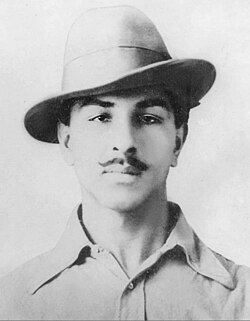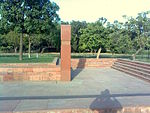Raj Ghat is a memorial complex in Delhi, India. The first memorial was dedicated to Mahatma Gandhi where a black marble platform was raised to mark the spot of his cremation on 31 January 1948 and consists of an eternal flame at one end. Located on Delhi's Ring Road, a stone footpath leads to the walled enclosure that houses the memorial. Later the memorial complex was expanded to include other memorials for other prominent people including Lal Bahadur Shastri, Charan Singh and Atal Bihari Vajpayee among the others.
| Raj Ghat | |
|---|---|
 Memorial of Bhagat Singh at Raj Ghat | |
| General information | |
| Type | Tomb |
| Location | Ring Road, Shahjahanabad, Delhi, India |
| Coordinates | 28°38′25.8″N 77°14′57.6″E / 28.640500°N 77.249333°E |
| Groundbreaking | 1948 |
Etymology
Raj Ghat loosely translates to Royal Steps with the word "royal" alluding to the importance of the place and "steps" referencing the climb from the banks of the Yamuna river.[1]
Location
Raj Ghat was the name of a location of historic ghat in Shahjahanabad in Old Delhi on the west bank of the Yamuna River east of Daryaganj.[2]
List of memorials
The first memorial was dedicated to Mahatma Gandhi on the spot where his remains were cremated on 31 January 1948. It consists of a black marble platform with an eternal flame at one end. A stone footpath leads to the walled enclosure that houses the memorial. Later the memorial complex was expanded to include several other samadhis for various leaders in the vicinity of Raj Ghat. The landscaping and planting of these memorials were originally performed by Alick Percy-Lancaster, Superintendent of Horticultural operations with the Government of India.[3][4][5][6]
In 2000, the Government of India under Vajpayee took a decision to not create separate memorials for different leaders as the already existing memorials were occupying more than 245 acres of prime land in Delhi.[7]
| Name | Title/Position | Date of death | Memorial name (Meaning in English) | Image |
|---|---|---|---|---|
| Mahatma Gandhi | Founder of Indian National Congress | 30 January 1948 | Raj Ghat (Royal Platform) |  |
| Jawaharlal Nehru | First Prime Minister of India | 27 May 1964 | Shanti Van (Forest of Peace) |  |
| Lal Bahadur Shastri | Second Prime Minister of India | 11 January 1966 | Vijay Ghat (Victory Platform) |  |
| Sanjay Gandhi | Grandson of Jawaharlal Nehru and former Member of Parliament | 23 June 1980 | Samadhi of Sanjay Gandhi (Tomb of Sanjay Gandhi) |  |
| Indira Gandhi | Third Prime Minister of India | 31 October 1984 | Shakti Sthal (Place of Strength) |  |
| Jagjivan Ram | Fourth Deputy Prime Minister of India | 6 July 1986 | Samta Sthal (Place of Equality) |  |
| Charan Singh | Fifth Prime Minister of India | 29 May 1987 | Kisan Ghat (Farmer Platform) |  |
| Rajiv Gandhi | Sixth Prime Minister of India | 21 May 1991 | Vir Bhumi (Land of Brave) |  |
| Lalita Shastri | Spouse of Lal Bahadur Shastri | 13 April 1993 | Samadhi of Lalita Shastri (Tomb of Lalita Shastri) |  |
| Giani Zail Singh | Seventh President of India | 25 December 1994 | Ekta Sthal (Place of Unity) |  |
| Shanker Dayal Sharma | Ninth President of India | 26 December 1999 | Karma Bhumi (Land of Duty) |  |
| Devi Lal | Sixth Deputy Prime Minister of India | 6 April 2001 | Sangharsh Sthal (Place of Struggle) |  |
| P. V. Narasimha Rao | Ninth Prime Minister of India | 23 December 2004 | Smriti Sthal (Place of Remembrance) |  |
| K. R. Narayanan | Tenth President of India | 9 November 2005 | Uday Bhumi (Land of Dawn) |  |
| Chandra Shekhar | Eighth Prime Minister of India | 8 July 2007 | Jannayak Sthal (Place of People's Leader) |  |
| R. Venkataraman | Eighth President of India | 27 January 2009 | Ekta Sthal (Place of Unity) |  |
| Inder Kumar Gujral | Twelfth Prime Minister of India | 30 November 2012 | Smriti Sthal (Place of Remembrance) |  |
| Atal Bihari Vajpayee | Tenth Prime Minister of India | 16 August 2018 | Sadaiv Atal (Firm Forever) |  |
Controversies
The hard materials used in the memorial had raised a few questions about the nature of Gandhian architecture where there is a stark difference between the architecture of Rajghat and a Gandhian low-cost housing architecture.[8]
P. V. Narasimha Rao was the ninth Prime minister of India. He died on 24 December 2004 at the All India Institute of Medical Sciences in Delhi.[9] His family wanted the body cremated at Raj ghat in Delhi. In 2015, almost ten years since his death, a memorial was finally erected at Smriti Sthal at the behest of the BJP government led by Narendra Modi.[10]
References
External links

